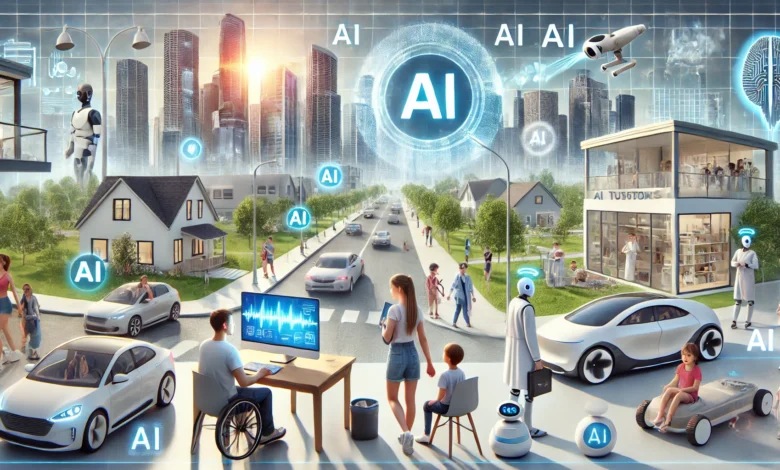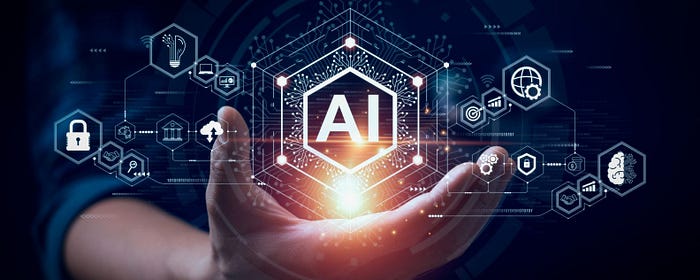AI in Everyday Life: How Artificial Intelligence Shapes Our Daily Routines

Artificial Intelligence AI in Everyday Life has quietly become one of the most influential technologies in our modern world. While it once sounded like something out of a science fiction movie, today AI is woven into the fabric of our everyday routines. From the moment we wake up to the time we go to bed, AI is working behind the scenes to make life more convenient, efficient, and sometimes even entertaining.
This article explores how AI in Everyday Life has seamlessly integrated into everyday life. We’ll break down its impact on communication, healthcare, education, entertainment, and even simple household chores. By the end, you might be surprised at just how much AI you’ve already been relying on without even realizing it.
Waking Up With AI: The Morning Routine

For many of us, mornings start with our smartphones. Whether you set an alarm, check the weather, or scroll through the news, AI in Everyday Life is already at work.
Smart alarms, for instance, don’t just buzz at the time you set; some use AI-driven sleep tracking to wake you at the optimal moment in your sleep cycle. This makes mornings less groggy and more natural. Your weather app relies on machine learning models to predict conditions in real-time, giving you accurate updates to plan your day. Even your music streaming service might use AI in Everyday Life to suggest an upbeat playlist that suits your morning energy.
Voice assistants like Siri, Alexa, or Google Assistant are another AI in Everyday Life-powered staple of the morning routine. With a simple voice command, you can get traffic updates, calendar reminders, or even start your coffee machine if it’s connected to a smart plug. These small conveniences may not feel revolutionary, but they represent how AI subtly improves efficiency right from the start of the day.
Perhaps the most overlooked part of this is personalization. AI in Everyday Life doesn’t just provide generic results—it learns your preferences over time. That’s why your news app highlights the topics you care about most, or why your smart speaker remembers which radio station you like to listen to. Mornings might still feel rushed, but with AI, they’re undeniably smoother.
AI in Everyday Life Communication and Social Media
Staying connected has never been easier, and AI in Everyday Life is largely responsible for this seamless communication. Whether it’s email, messaging apps, or social media platforms, AI ensures that information flows in ways that feel natural and personalized.
Take email, for example. Spam filters powered by AI in Everyday Life save us from the clutter of unwanted messages by learning to recognize patterns in harmful or irrelevant emails. Smart replies and predictive text also make responding faster and more convenient. Gmail’s ability to finish your sentences isn’t magic—it’s machine learning in action.
Social media platforms are perhaps the most obvious example of AI in Everyday Life. Your Facebook or Instagram feed isn’t random—it’s carefully curated by algorithms that predict what posts you’ll find most engaging. TikTok’s “For You Page” is one of the clearest demonstrations of AI, as it continuously learns your preferences and tailors videos to keep you scrolling. While this raises important questions about digital well-being, it also highlights the sophistication of AI in understanding human behavior.
On the communication side, AI in Everyday Life driven translation tools are breaking down language barriers. Apps like Google Translate or Microsoft Translator allow real-time conversations between people who don’t share a common language. This level of accessibility and connection would have been unimaginable a couple of decades ago.
In short, AI in Everyday Life is no longer just a tool—it’s become an invisible companion in how we communicate and stay connected globally.
Smarter Homes: AI in Everyday Life
One of the most noticeable areas where AI in Everyday Life has made its mark is within our homes. Smart home technology has transformed the way we manage our living spaces, bringing convenience and energy efficiency to a whole new level.
AI-driven devices like smart thermostats learn your heating and cooling preferences over time. Instead of manually adjusting the temperature, your thermostat adapts to your lifestyle—warming your home before you wake up or saving energy while you’re away. Similarly, AI in Everyday Life powered lighting systems can automatically adjust brightness based on the time of day or your habits, creating both comfort and efficiency.
Voice-controlled smart assistants extend this convenience even further. Imagine asking Alexa to lock your doors, dim the lights, or order groceries. Behind these simple commands is AI in Everyday Life that interprets language, predicts intent, and executes tasks seamlessly. It’s a futuristic touch that many households are already experiencing.
AI also plays a role in home security. Smart cameras and doorbells, like Ring or Nest, use AI in Everyday Life to recognize faces, detect unusual movements, and even differentiate between a passing car and a potential intruder. This means fewer false alarms and greater peace of mind.
Ultimately, AI in Everyday Life has turned houses into intelligent environments. What was once a futuristic dream of “smart homes” is now an everyday reality powered by artificial intelligence.
AI in Everyday Life Healthcare and Personal Wellness
Healthcare is one area where AI in Everyday Life influence can be truly life-changing. While we often think of doctors and nurses as the main caregivers, AI now plays a supporting role that enhances diagnosis, treatment, and personal wellness.
Wearable devices like smartwatches track heart rates, sleep cycles, and physical activity. But the real magic happens when AI in Everyday Life processes this data to provide personalized health insights. For instance, your watch might alert you to irregular heartbeats or encourage you to move if you’ve been inactive for too long. This kind of monitoring helps individuals take control of their own health before problems escalate.
In clinical settings, AI in Everyday Life assists doctors in diagnosing diseases with greater accuracy. Machine learning algorithms can analyze medical images, such as X-rays or MRIs, and spot abnormalities that even trained eyes might miss. This speeds up the diagnostic process and increases the chances of early detection for conditions like cancer.
Mental health apps also use AI in Everyday Life to provide support. Chatbots and digital therapists are designed to recognize emotional cues from your text inputs and respond empathetically. While they don’t replace professional therapists, they do provide accessible help for those who may not otherwise seek support.
With AI in Everyday Life growing presence in healthcare, it’s safe to say that our wellness is increasingly shaped not just by medical expertise but also by technological intelligence working silently in the background.
AI in Everyday Life Education and Learning
Education has undergone a transformation thanks to AI, and students today have tools that previous generations couldn’t even imagine. Whether it’s personalized learning or accessibility, AI in Everyday Life has redefined how we gain knowledge.
Online learning platforms like Coursera, Khan Academy, or Duolingo rely on AI in Everyday Life to adapt lessons to each student’s progress. If you’re struggling with a concept, the system slows down and provides more practice. If you’re excelling, it moves faster, ensuring that you remain challenged but not overwhelmed. This individualized approach makes education more effective and less rigid.
AI in Everyday Life-driven tools also make learning more accessible. Text-to-speech and speech-to-text technologies help students with disabilities participate fully in classrooms. Translation tools make global knowledge available across language barriers. Even plagiarism checkers, powered by machine learning, ensure academic integrity by detecting copied content with impressive accuracy.
Perhaps the most fascinating application is the rise of AI in Everyday Life tutors. These digital assistants provide round-the-clock support, answering questions, explaining difficult topics, and offering practice problems. For students without access to private tutors, this can be a game-changer.
Education has always been about adapting to the needs of learners, and AI in Everyday Life is simply the next evolution in making knowledge more personal, accessible, and engaging.
AI in Entertainment and Leisure
When it comes to relaxation, AI in Everyday Life ensures that entertainment is tailored to individual tastes. From streaming platforms to video games, artificial intelligence is everywhere in leisure activities.
Take Netflix or Spotify, for example. Their recommendation engines analyze what you’ve watched or listened to and suggest similar content. This personalization keeps us entertained without the struggle of choosing from endless options. The fact that Netflix can predict what show you might want to binge-watch next is no coincidence—it’s AI in Everyday Life learning your behavior.
In gaming, AI in Everyday Life plays a dual role. Not only does it power intelligent opponents that adapt to your skill level, but it also enhances graphics, creates lifelike environments, and drives immersive experiences. Games are no longer just about beating programmed levels—they’re about interacting with worlds that feel responsive and alive.
Even creative industries are embracing AI in Everyday Life. Musicians, filmmakers, and writers now use AI-driven tools to brainstorm ideas, generate music, or edit footage. While some worry that this might replace human creativity, most see it as a collaborative tool that enhances rather than replaces artistic expression.
Entertainment has always been about enjoyment, and AI in Everyday Life has made sure that what we consume is more personal, engaging, and innovative than ever before.
The Future of AI in Everyday Life
While AI already feels like an inseparable part of daily life, its future potential is even more exciting. Think about self-driving cars that eliminate traffic stress, AI-powered personal shoppers that understand your style better than you do, or virtual assistants that can hold truly human-like conversations.
At the same time, we must acknowledge challenges. Questions about data privacy, job automation, and algorithmic bias remind us that AI’s growth must be handled responsibly. Striking the balance between convenience and ethical use is one of the key discussions for the future of AI.
Nevertheless, the trajectory is clear—AI will continue to integrate more deeply into our everyday lives. The line between human decision-making and artificial intelligence will blur, and our daily routines will become more efficient, informed, and personalized.
Final Thoughts
AI in everyday life is no longer a futuristic idea—it’s today’s reality. From waking up to personalized alarms to winding down with curated entertainment, AI quietly supports nearly every aspect of our routines. It keeps us connected, improves our health, enhances learning, and even makes our homes smarter.
While challenges exist, the overall impact of AI on everyday life has been overwhelmingly positive. The key is to remain mindful of how we use this technology and ensure it continues to benefit humanity as a whole.
The truth is, AI has already become an invisible assistant, shaping our decisions, habits, and experiences in ways we rarely stop to notice. As technology advances, it will only become more embedded in our lives—and chances are, we’ll wonder how we ever lived without it.



